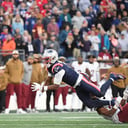Bill Belichick was more jovial after the New England Patriots’ surprise win over the Buffalo Bills on Sunday than at any other point this season. His team, at long last, looked like he’d envisioned. The offense moved the ball with ease, the defense came up with a turnover and some red zone stops, and the kicking game was efficient even on a windy day.
Advertisement
But it was the offense that was the biggest revelation. The Patriots entered this game ranked near the bottom of the league in nearly every statistic — then suddenly averaged 6.6 yards per play and put up 29 points against the Bills.
So how did the offense wake up? And is it sustainable? Let’s explore the changes that yielded this breakout.
A short passing game
After the Patriots’ blowout loss to the New Orleans Saints in Week 5, offensive coordinator Bill O’Brien made a drastic change to the passing game. He decided the team’s offensive line wasn’t good enough to be counted on for long stretches — the kind of time required for deep dropbacks. And he decided the team’s wide receivers weren’t good enough to consistently create separation downfield from the cornerbacks covering them.
So, he did away with the team’s deep passing game and did largely the same with intermediate routes. Quarterback Mac Jones often talks about a passing offense needing to fill three buckets: the deep game, the intermediate game and the short game. But the Pats switched to an offense that overflows the easiest bucket to fill.
After making the switch, Jones’ passes against the Las Vegas Raiders in Week 6 went an average of just 5.3 yards past the line of scrimmage, which is one way to minimize how long the offensive line has to hold blocks. That led to some success, even if the Pats fell short in that game.
A week later, O’Brien made even more drastic changes. His goal against the Bills was simple: get the ball out quickly and throw it short.
On Sunday, Jones’ average time to throw was 2.19 seconds, the quickest of all quarterbacks in Week 7. Jones’ average target was 3.3 yards past the line of scrimmage, which is the third-shortest air yards per attempt of any quarterback in a game this season, behind only Justin Fields of the Chicago Bears in Week 1 and fellow Bears quarterback Tyson Bagent, who averaged 2.0 yards in his starting debut Sunday.
Advertisement
It’s easy to knock a passing offense that’s so reliant on the short game. But in a league where defenses are actively taking away the deep game, it worked for the Patriots. Perhaps it’s not a coincidence that Sunday was easily Jones’ best game of the season. He completed 83 percent of his passes for 272 yards, two touchdowns and no interceptions.
Bourne for this 😤@MacJones_10 | @BournePoly11
📺 on @NFLonCBS pic.twitter.com/zuLs7lwu9G
— New England Patriots (@Patriots) October 22, 2023
Look for the short passing game to continue into next week against a Miami Dolphins defense coordinated by Vic Fangio that often plays with two deep safeties to take away big plays in the passing game.

GO DEEPER
Dysfunction creeping in as Patriots, Mac Jones flail again in loss to Commanders
Lean on Demario Douglas
The sixth-round pick was the star of training camp and seemed in line to be a day-one starter. But the Patriots were careful not to put too much on the rookie’s plate. Even after an impressive debut (four catches for 40 yards), wide receivers coach Troy Brown said Douglas had several areas where he needed to improve.
Thus commenced an ease-him-in plan even though it seemed clear that Douglas was one of the team’s most electric receivers — if not its very best. Coaches didn’t let Douglas play more than a third of the offensive snaps after the opener.
Until Sunday’s game.
In search of a spark, O’Brien finally turned to Douglas for a bigger role, and the 22-year-old delivered. He finished Sunday with five touches for 74 yards and returned one punt for 25 yards.
He is Poppin.@popshotta3 | #ForeverNE
📺 on @NFLonCBS pic.twitter.com/OcIZMnrAk2
— New England Patriots (@Patriots) October 22, 2023
The team’s plan to get him the ball more was clear from the opening play where O’Brien called for a quick pass to Douglas, which the receiver turned into a 9-yard gain.
In years past, the Patriots had the luxury of easing in a rookie, especially a late-round pick. But with this group of receivers, the idea of making Douglas earn more opportunities through minimal playing time wasn’t working.
Advertisement
Now, Douglas has shown he should be getting plenty of playing time even if JuJu Smith-Schuster returns this week from a concussion.
Change the offensive line
For more than a year, Belichick has wanted to avoid moving Mike Onwenu from right guard to right tackle. His thinking went something like this: Why mess with what’s working? Onwenu had played for long stretches as one of the best guards in football. So even if there’s more of a premium on right tackles, don’t rock the boat and risk that Onwenu’s play dips by going back to the position he played as a rookie.
But after right tackle had been the Patriots’ biggest positional weakness the first six weeks, Belichick finally moved Onwenu outside. He followed that up by shifting rookie Sidy Sow, whom the Patriots drafted in the hope he could play tackle, to right guard. Even if those aren’t the positions the Pats eyed for those players in the long term, it yielded the best short-term answer and by far the offensive line’s best game of the season.
Onwenu and Sow played very well. Sow was graded as the second-best guard in Week 7, according to Pro Football Focus. The Bills put pressure on Jones on only 21 percent of his dropbacks, Buffalo’s second-worst pass-rushing performance of the season.
If the Patriots stick with that offensive line (and can stay healthy), there’s reason to believe the group can continue playing well.
So, is it sustainable?
On one hand, the Patriots offense is coming off its best performance of the season. Jones isn’t being asked to do too much, he finally has a receiver in Douglas who can make people miss and his offensive line is doing a much better job of blocking.
On the other hand, it’s hard to have a consistent passing game with little threat of beating teams downfield, Douglas’ durability is a concern after multiple injuries already to start his NFL career and the offensive line’s continued improvement is no sure bet.
Advertisement
The guess here is that the offense will continue to find success in the coming weeks. The Patriots’ next three opponents (the Dolphins, Washington Commanders and Indianapolis Colts) rank in the bottom six in the NFL in points allowed. New England’s new offensive scheme could be effective against those teams.
The question will then become this: Once opponents start daring the Patriots to beat them deep by taking away Douglas and their short-passing game, will O’Brien develop a counterpunch?

GO DEEPER
Buckley: Pats' season of frustration goes from JuJu Smith-Schuster's fingers to acceptance
(Photo of Demario Douglas: Billie Weiss / Getty Images)
“The Football 100,” the definitive ranking of the NFL’s best 100 players of all time, is on sale now. Order it here.

